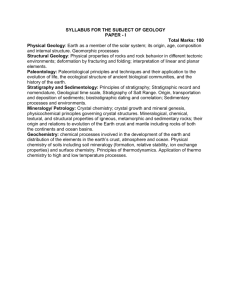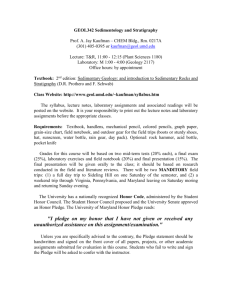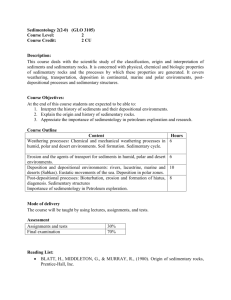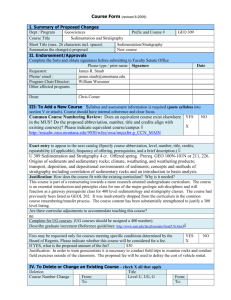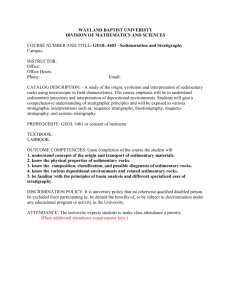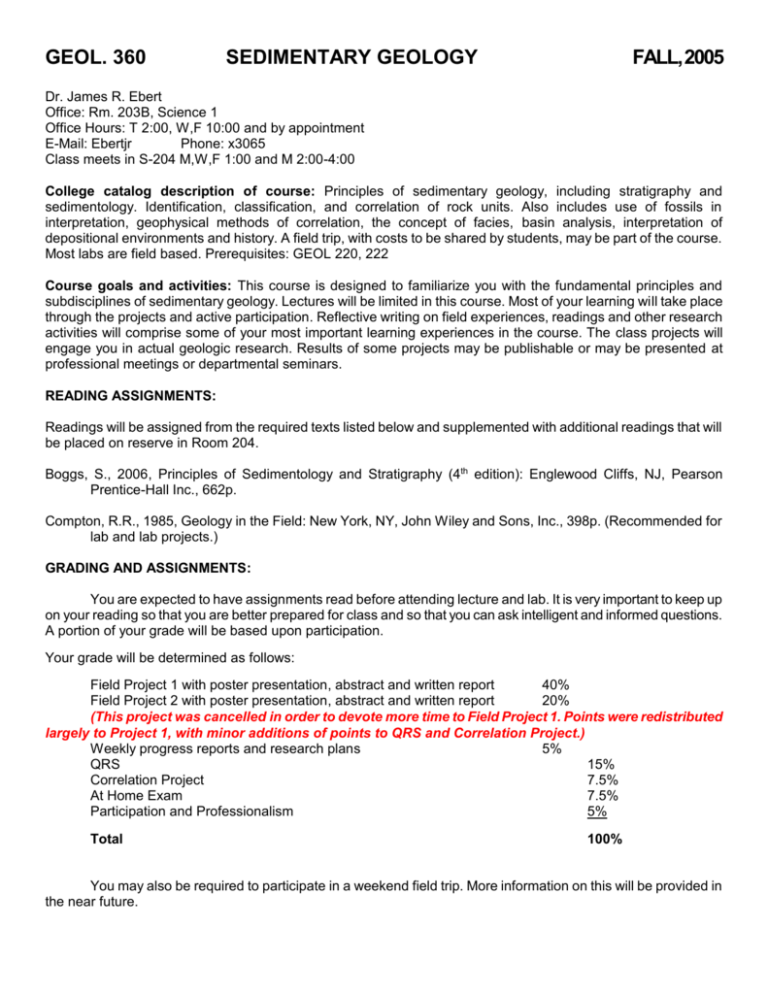
GEOL. 360
SEDIMENTARY GEOLOGY
FALL, 2005
Dr. James R. Ebert
Office: Rm. 203B, Science 1
Office Hours: T 2:00, W,F 10:00 and by appointment
E-Mail: Ebertjr
Phone: x3065
Class meets in S-204 M,W,F 1:00 and M 2:00-4:00
College catalog description of course: Principles of sedimentary geology, including stratigraphy and
sedimentology. Identification, classification, and correlation of rock units. Also includes use of fossils in
interpretation, geophysical methods of correlation, the concept of facies, basin analysis, interpretation of
depositional environments and history. A field trip, with costs to be shared by students, may be part of the course.
Most labs are field based. Prerequisites: GEOL 220, 222
Course goals and activities: This course is designed to familiarize you with the fundamental principles and
subdisciplines of sedimentary geology. Lectures will be limited in this course. Most of your learning will take place
through the projects and active participation. Reflective writing on field experiences, readings and other research
activities will comprise some of your most important learning experiences in the course. The class projects will
engage you in actual geologic research. Results of some projects may be publishable or may be presented at
professional meetings or departmental seminars.
READING ASSIGNMENTS:
Readings will be assigned from the required texts listed below and supplemented with additional readings that will
be placed on reserve in Room 204.
Boggs, S., 2006, Principles of Sedimentology and Stratigraphy (4th edition): Englewood Cliffs, NJ, Pearson
Prentice-Hall Inc., 662p.
Compton, R.R., 1985, Geology in the Field: New York, NY, John Wiley and Sons, Inc., 398p. (Recommended for
lab and lab projects.)
GRADING AND ASSIGNMENTS:
You are expected to have assignments read before attending lecture and lab. It is very important to keep up
on your reading so that you are better prepared for class and so that you can ask intelligent and informed questions.
A portion of your grade will be based upon participation.
Your grade will be determined as follows:
Field Project 1 with poster presentation, abstract and written report
40%
Field Project 2 with poster presentation, abstract and written report
20%
(This project was cancelled in order to devote more time to Field Project 1. Points were redistributed
largely to Project 1, with minor additions of points to QRS and Correlation Project.)
Weekly progress reports and research plans
5%
QRS
15%
Correlation Project
7.5%
At Home Exam
7.5%
Participation and Professionalism
5%
Total
100%
You may also be required to participate in a weekend field trip. More information on this will be provided in
the near future.
SCHEDULE OF CLASSES, PROJECTS AND ASSIGNMENTS
(Subject To Change As Necessary)
Date
8/24
8/26
Topic
Assignment
Overview of Course, Concepts through Case Studies, Projects,
Scudder Essay
Readings, QRS and Socratic Discussion, Reflective Writings
Discuss Scudder; Observations and Inferences
B3
Assignment
Due
Scudder QRS
8/29
FIELD TRIP: Introduction to the lower Helderberg Group and
Data, hypotheses,
assignment of study intervals – Tools of the trade, observations,
and questions
measuring section, data collection, inferences and questions
8/31
Discussion of Field Trip Data, Hypotheses & Questions;
The Nature of Science
9/2
Composition, Texture and Classification of Carbonate Rocks
B6
Progress
and Plan
9/7
FIELD PROJECT 1: Sedimentology and Depositional
Environments of the lower Helderberg Group
Composition, Texture and Classification of Carbonate Rocks
9/9
Composition, Texture and Classification of Carbonate Rocks
B4
9/12
FIELD PROJECT 1: Sedimentology and Depositional Environments of the lower Helderberg Group
Sedimentary Structures: Processes & Paleoenvironmental
B 4 QRS
Significance
Sedimentary Structures: Processes & Paleoenvironmental
B 11
PRP
Significance
9/5
9/14
9/16
B 3 QRS
Data, hypotheses
and questions
Report
B 6 QRS
Progress Report
and Plan (PRP)
9/19
9/21
9/23
FIELD PROJECT 1: Sedimentology and Depositional Environments of the lower Helderberg Group
Introduction to Modern Carbonate Environments
B 11 QRS
Modern Carbonate Environments – continued
Paleo. Readings
PRP
9/26
9/28
FIELD PROJECT 1: Sedimentology and Depositional Environments of the lower Helderberg Group
Modern Carbonate Environments – continued
Laporte (1969), B 14
Paleo. QRS
Paleontology and Paleoecology in Sedimentologic Analysis
At Home Exam
PRP
9/30
10/3
10/5
10/7
10/10
Correlation Charts and an Overview of Helderberg Stratigraphy – The Legacy of Rickard and Laporte
LAB: Sample Preparation and Analysis
The Silurian – Devonian Boundary: a GSSP Case Study and the
At Home Exam
Search in New York
B 14 QRS
Tucker, et. al.
Discussion of Laporte: Helderberg Paleoenvironments and
(1998)
Modern Analogs – a textbook example of comparative
Laporte QRS
Ebert & Matteson
sedimentology
(2003a,b)
FIELD PROJECT 1: Field Checking/Lab Work
Preparation of Posters, Abstracts and Reports
10/12-14 No Classes
10/17
FIELD PROJECT 1: Field Checking/Lab Work
10/19
The S – D Boundary – a Case Study in Radiometric Dating
10/21
Reconfiguring Helderberg Stratigraphy/ Discussion of Ebert and Matteson (2003a,b)
10/24
FIELD PROJECT 2: Comparative Sedimentary Petrology within
Progress Report
the Catskill Clastic Wedge (NOTE: This project was
and Plan (PRP)
abandoned in favor of continuing Project 1.)
B1
Tucker, et.
QRS
E & M QRS
al.
10/26
Weathering, Soil and Siliciclastic Sediments
Poster Session 1: Posters, Abstracts, Project Reports (This
10/28
presentation session was moved to the end of the on Field Project 1; PRP
semester to accommodate expansion of Project 1.)
10/31
11/2
11/4
11/7
11/9
11/11
FIELD PROJECT 2: Comparative Sedimentary Petrology within
the Catskill Clastic Wedge
Sedimentary Tectonics and the Provenance of Siliciclastic
Sediments
Basins, Subsidence and Sedimentary Tectonics
B 1 QRS
Posters, Abstracts and Project Reports
Progress
and Plan
Report
PRP
STANYS Conference: Sample preparation/analysis and
Preparation of posters
Foreland Basin Case Study: Catskill Clastic Wedge: Catskill,
Marginal Marine, Chemung & Portage Magnafacies
Diagenesis: What Happens After Deposition?
FIELD PROJECT 2: Comparative Sedimentary Petrology within
the Catskill Clastic Wedge
Porosity and Permeability – The Practical Consequences of
11/16
Depositional Processes and Tectonic Setting
11/18 Geochemical and Geophysical Correlation
11/19-27 No Classes
Geochemical and Geophysical Correlation
11/28
LAB: Subsurface Correlation – Applying a New Paradigm
11/30 Sequence and Global Event Stratigraphy
Poster Session 2: Posters, Abstracts, Project Reports
12/2
Discussion of plans for GSA writing/submission – both
projects
11/14
PRP
Progress
and Plan
Progress
and Plan
Report
Report
PRP
Posters, Abstracts
Reports Due
and
Project
Continue Discussion Re: GSA writing/submission
Sequence and Global Event Stratigraphy
LAB: Subsurface Correlation
Sequence and Global Event Stratigraphy
12/7
Peer Editing of Abstracts for NEGSA ‘06
12/9
12/13 is Deadline for Submission
12/14 FINAL EXAM 11:00 – 1:30 Discussions: Presentation and Discussion of Subsurface Correlations
The Nature of Science; The Future of Sedimentary Geology;
12/5
READING ASSIGNMENTS: B = Boggs, C = Compton
Numbers are chapter numbers.



